
by Sandra Eckert
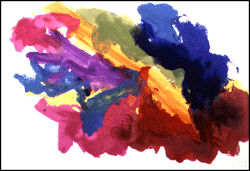
Whalesongs have been described as both haunting and joyous; regardless of personal response, most people agree that they are compelling and provide the stimuli for a variety of creative experiences. In this exercise, I propose the use of whalesongs as the basis for an "Action Painting" experience, based on the work of the artists described in the "background/motivation" section, which follows:
Background/motivation
Students should study the following artists and their work:
First Generation Abstract Expressionists:
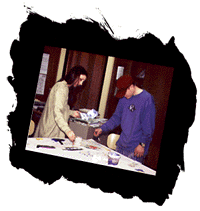
| Artist: | Suggested Painting: |
| Willem deKooning | "Woman1", 1950-1952 |
| Jackson Pollock | "Number 27, 1950", 1950 |
| Second Generation Abstract Expressionists: | |
| Mark Rothko | "Four Darks in Red", 1958 |
| Helen Frankenthaler | "Mountain Storm", 1955 |
| Franz Kline | "Mahoning", 1956 |
| Alfred Leslie | "Soldier's Medal", 1959 |
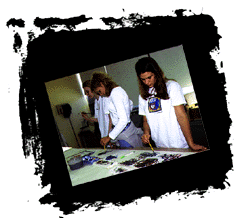
Students should note the differences in the artworks based upon the use of color, shapes, line quality, degree of realism or abstraction (recognizable subject matter?), and finally, their personal emotional response to the individual works. This activity will provide a good opportunity for a cooperative learning segment, prior to the more individualized studio component of this exercise. Some questions they might ask themselves are as follow:
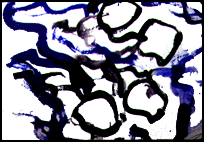
- What do I feel when I look at this painting?
- What formal qualities contribute to this feeling?
- Are there straight lines or curved lines? (Are there lines at all?)
- Are the colors bold of somber? Violent or passive?
- Are the areas hard-edged or soft-edged?
- Are there any recognizable images?
- What (if anything) does the painting remind me of?
- If you had to choose a type of music to go with this painting, what kind would you choose? (Have students respond with as many descriptive phrases as possible, listing style, musical artist, even song title)
Homework Assignment
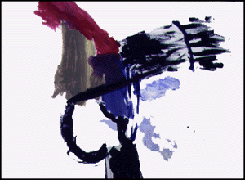 Choose a song that reminds you of one of the paintings you saw in class today. Bring it in tomorrow.
Choose a song that reminds you of one of the paintings you saw in class today. Bring it in tomorrow.
Play the various songs while looking at the various paintings. Have the students respond to the combinations. Do they agree with the choices? Why or why not?
Studio motivation
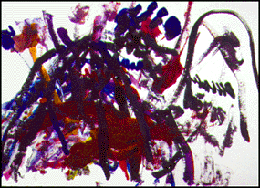 Have the students experiment with a variety of brushes (preferably larger brushes) and colors of tempera paint. Discuss the various colors they mix, and the emotions those colors evoke. Ask the students where they might have seen those colors before ("hospital green", etc.), and why they think those colors were used. Encourage them to experiment with a variety of markmaking techniques as well.
Have the students experiment with a variety of brushes (preferably larger brushes) and colors of tempera paint. Discuss the various colors they mix, and the emotions those colors evoke. Ask the students where they might have seen those colors before ("hospital green", etc.), and why they think those colors were used. Encourage them to experiment with a variety of markmaking techniques as well.Studio Experience
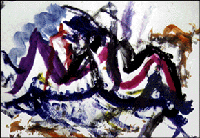 Darken the lights in the room. Instruct the students to sit quietly, with their their eyes closed, and explain that they will be listening quietly to whalesongs. Have them imagine how their paintings might express the mood the whalesongs evoke. Have the students prepare pans of colors they wish to use in their paintings.
Darken the lights in the room. Instruct the students to sit quietly, with their their eyes closed, and explain that they will be listening quietly to whalesongs. Have them imagine how their paintings might express the mood the whalesongs evoke. Have the students prepare pans of colors they wish to use in their paintings.
Both pans and paintings should be large enough to allow for free, spontaneous movement. Cover the tabletops with newspaper, move back the chairs, and calm the students. Have them attempt to return to the emotions they felt when hearing the whalesongs. Dim the lights, if possible, begin the music, and have the students respond to their mood visually, with the materials provided. Reinforce the use of color, gesture, and shape.
Evaluation
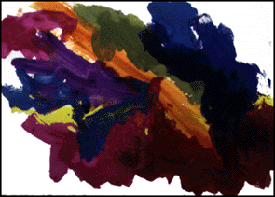 Evaluation should be based upon the degree of concentration and the appropriateness of their work to the music. However, do not prejudge those works that at first glance might seem inappropriate. Suggest that the student artist describes the reasoning behind the choices that were made. Their descriptions may provide clues to a more accurate evaluation of their work, just as researching a historical artwork may lead to understanding of the artist's intent.
Evaluation should be based upon the degree of concentration and the appropriateness of their work to the music. However, do not prejudge those works that at first glance might seem inappropriate. Suggest that the student artist describes the reasoning behind the choices that were made. Their descriptions may provide clues to a more accurate evaluation of their work, just as researching a historical artwork may lead to understanding of the artist's intent.